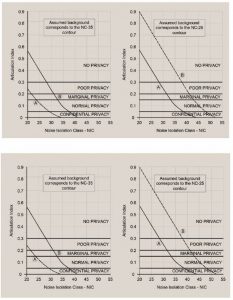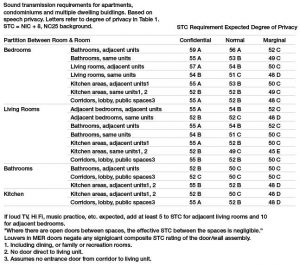Cutting through the noise on wall construction

NIC assesses the simultaneous combined effect of the last four factors mentioned earlier (NIC is a single number rating computed in accordance with ASTM 413, Standard Classification for Determination of Sound Transmission Class, based on individual noise reduction [NR] measurements). NIC makes sense only in field conditions, so it is often referred to as FNIC, meaning field-tested.
The purpose of STC, ASTC, and NIC measures is to minimize TL or NR—measured in 16 1/3 octave bands—from 125 through 4000 Hz to a single number rating. The ‘class’ rating permits gross comparison of the acoustical attenuation of partitions. However, TL and NR are frequency dependent (i.e. they vary with frequency for any given construction or room absorption). STC, ASTC, and NIC do not consider attenuation or acoustical absorption in frequencies lower than 125 Hz. Often, problems of room-to-room sound transmission lie in the lower frequencies.
STC, ASTC, and NIC are erroneously utilized interchangeably. However, each has a specific application and meaning. Improper use in specifications can result in unintended consequences if the attendant acoustical performance is brought into question.
All three of these rating systems are similar in that they are a single number derived from measuring sound attenuation (TL or NR) from one location to another in 1/3 octave bands from 125 Hz through 4000 Hz. All three compute the single number rating by the same procedure, even though the process refers to STC—ASTC and NIC evolved from STC to meet specific needs.

STC and ASTC procedures are specifically applicable to walls. In STC and ASTC, TL refers to attenuation values corrected for the acoustical absorption of the receiving space. The reason for the correction is they are not intended to measure the sound isolation values of the wall. STC is a laboratory test procedure. ASTC is an in-situ field test procedure. All flanking paths—sound transmitted at the wall/ceiling and the wall/floor transition—are taken into account in calculating the single STC number. In lab tests, these flanking paths are sealed as best as possible.
NIC measures only the sound attenuation between two spaces, and calls this NR. NR is most meaningful in real-world situations where the total sound in the receiving space is at issue.
STC provides a comparison of wall acoustical insulation properties based on basic construction only. Generally, it is not a good idea to use STC in wall specifications where the intent is really ASTC or NIC. It is best to use when specifying specific sub-assemblies such as doors and windows.
ASTC measures not only the transmission properties of the wall construction, but also all the transmission through flanking paths (cracks, etc.). This is appropriate for specifications if the intent is to identify the total acoustical insulation properties, but exclude sound absorption in the receiving space.
NIC is appropriate if the goal is to identify the total acoustical insulation properties including sound absorption in the receiving space. In other words, it specifies the acoustical insulation regardless of how it is achieved.
Key issues in room-to-room privacy include:
- room-to-room sound transmission; and
- background sound in the listener’s room.
Room-to-room sound transmission is best defined by NR since it includes all of the following parameters:
- wall transmission loss;
- common wall area;
- sound flanking paths; and
- absorption in the listener’s room.
Of course, the level of the speaker’s voice is also an important parameter, but not one within the purview of the design team. In Figure 2, NR values were taken from the standard noise isolation contour for the stated NIC and the background in the listener’s room corresponds to the noise criterion curve. A speech spectrum curve is taken from the American National Standards Institute (ANSI) S3.5, Methods For Calculation Of The Speech Intelligibility Index, and the typical speech level is adjusted to 78 dBA. Two speech levels are used—standard (78 dBA) and raised (88 dBA).
The two graphs in Figure 2 relate privacy to NIC for both speech levels. The two lines identified as (A) are results for standard speech spectra and (B) is for raised voice assumption.
Without going into the numerous technical and peripheral issues, Figure 2 is an illustration of privacy as related to noise reduction and background in the receiving room.



